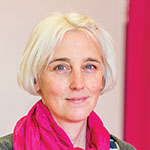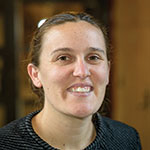ATS Mythbusters: Bioengineering Approaches Will Revolutionize Respiratory Medicine in the Next 10 Years (A86)
2:15-4:15 p.m.
Sunday
Pacific Ballroom 18-19 (North Tower, First Floor), Marriott Marquis San Diego Marina
Exciting advances in iPS cell differentiation and ex vivo lung tissue bioengineering are gaining new attention as potential therapies for lung disease and transplantation. Stripping away the myths from the facts surrounding these recent advances is the goal of Sunday’s session, “Mythbusters: Bioengineering Approaches Will Revolutionize Respiratory Medicine in the Next 10 Years.”
Specifically, session leaders Melanie Königshoff, MD, PhD, professor of medicine at the University of Colorado, and Darcy Wagner, PhD, a Wallenberg Molecular Medicine Fellow and assistant professor at Sweden’s Lund University, will explore the debate of whether exogenous cells are necessary to induce regeneration or if iPS cells, in the absence of a transplantable matrix, will be sufficient for exogenous approaches to regeneration. A group of leading experts in this field will discuss whether acellular human scaffolds are necessary for ex vivo regeneration of lung tissue for transplantation or if xenogeneic scaffolds can be used.
“Advances in iPS cell differentiation and ex vivo lung tissue bioengineering are important for researchers working in both fields, since one of the visions is that these technologies can be merged to generate functional lung tissue for transplantation,” Dr. Königshoff says. “If the patient’s own cells can be used, it may minimize the long list of complications that often are encountered following clinical transplantation. Additionally, if the promise of bioengineered organs can be achieved, it can address the huge shortage of organs for lung transplantation,” Dr. Wagner adds.
In addressing myths in the debate, Dr. Wagner says there has been clinical success in regeneration of other organs and tissues, despite the absence of exogenous cells in the transplanted matrix. However, for the lung, because it has a more complex architecture and is heavily vascularized, researchers believe cells will be necessary for a tissue engineering approach. Conversely, other recent research suggests that if the proper cells are used and cell signaling pathways are tightly controlled with growth factors and small molecules, these cells can contain the necessary information to regenerate structures that resemble the native architecture. It is not yet known if replication of developmental programs using iPS cells will be able to achieve complete organ generation.
According to Dr. Königshoff, another potential application of both fields of research, and in particular iPS cells, is to model diseases in a dish. This provides a platform for drug testing and for personalized medicine approaches on cells derived from individual patients. In many diseases, such as cystic fibrosis, there are several known mutations. Therefore, testing different drugs on differentiated iPS cells may help predict patient responses.
“This research has huge implications for drug targeting,” says Dr. Wagner. “If you only treat the cells and do not treat the underlying matrix, the disease will likely persist since the cells will continue to receive pathologic cues.”
For attendees, the session will not only explore the myths in recent advances of both approaches, it will spark further dialogue about how these two fields can interact more.
“There already have been several studies that combined these approaches, but more are needed to really understand how regeneration using adult, endogenous stem and progenitor, or iPS cells can be achieved,” Dr. Königshoff says. “Clinicians and basic scientists will certainly come away with new ideas and new questions about the many gaps that still exist between these two fields.”


